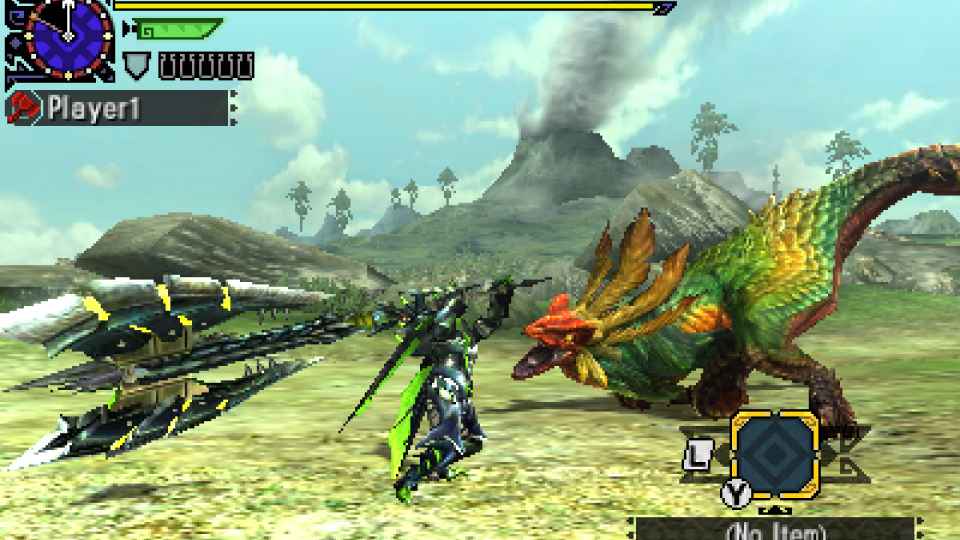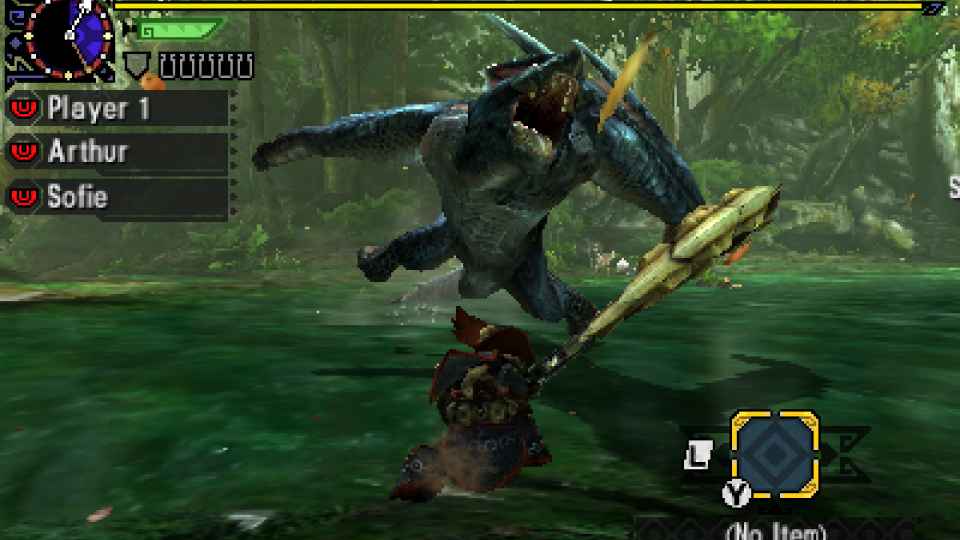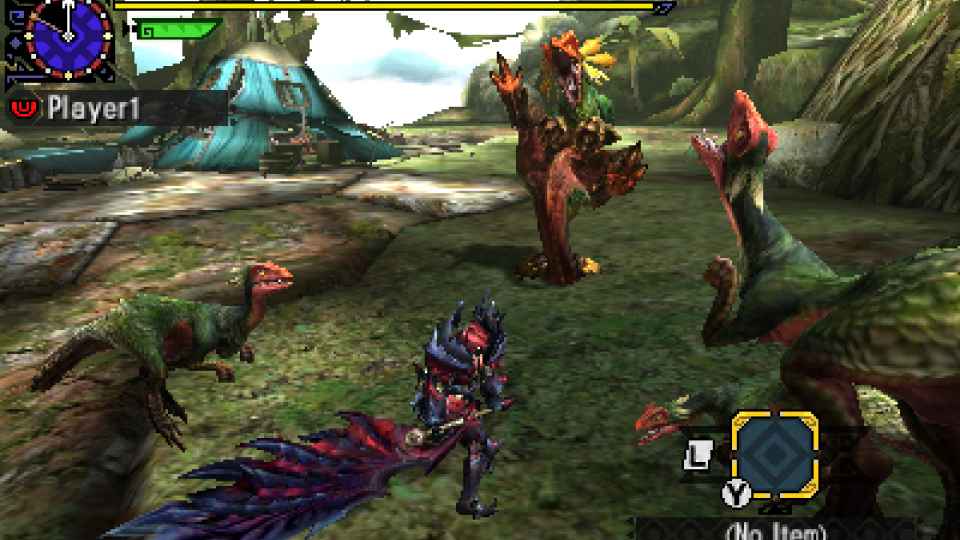Now that's what I call Monster Hunter. Billed as a kind of greatest hits of the series' past and present, Generations is a loving celebration of all those years we've spent sawing off bits of dinosaur to craft ourselves ever fancier hats, belts and boots.
Twelve years, to be precise, but for recent Nintendo converts it will probably feel like business as usual, as Capcom's latest entry in its dino hacking franchise is very much of the same bloodline as its immediate predecessors, Monster Hunter Tri and 4 Ultimate .
Indeed, you'll even find Tri's Moga Village available as one of the playable locations in Generations, albeit now as an abandoned outpost on its equally deserted island. Characters from across the series will also rock up in each of Generations' four, unique towns, and completing certain villager requests will only bring more familiar faces back to the fold once they hear about your daring feats of high-octane monster slaying.

However, for a game so clearly focused on pleasing its fans, Generations still fails to address many of the same pitfalls Monster Hunter's been falling into ever since the series' inception. The opening hours, for instance, continue to be a bit of a slog, and it shares many of the same bad habits as Tri, overburdening you with dozens of mushroom gathering and fern picking quests at the start rather than simply cutting to the chase like 4U.
You still need to do a fair amount of busy work, then, before you can really chow down on the meat of Generations, but once you've cut your teeth on those tedious appetisers, so to speak, it really is a lip-smacking feast of a game. Larger monsters start coming thick and fast once you hit the 3-star quest ranks, both in their own dedicated quests as well as potential threats in others, and the fact you can visit all four hub towns and their accompanying hunting grounds within a couple of hours means you get to see a lot more of what Generations has to offer upfront than any of its immediate predecessors. Whether its the frozen mountains of Yukumo, the scorching deserts of Bherna, the alpine foothills of Pokke or the sprawling savannahs of Kokoto, the world is your oyster here, and the freedom afforded by its open-ended story structure is a welcome tonic to the rather more linear campaign of Monster Hunter 4U.
Then again, when each town is essentially a clone of the other, offering the same services and collection of quests as the last just with a different flavour of cultural window-dressing, it begs the question why Capcom felt the need to split the world into four in the first place, as everything could theoretically be managed from one central location. You still need to return to certain villagers after completing specific quests, for instance, and traipsing back and forth between villages just creates more needless to-ing-and-fro-ing that drags down the pace of your mission downtime.
In a way, it almost feels like Capcom's over-complicating things simply for the sake of having more content, and nowhere is this more evident than the changes it's made to Generations' overall combat. You won't find any new weapon classes here, but the fourteen returning roles from 4U all have a few new tricks up their sleeve. These come in the form of Hunter Arts – special abilities that can turn the tide in battle or boost your power of evasion – and Hunter Styles.
Your Style dictates how many Arts you can assign, so those that favour doling out large, superpowered attacks will probably find themselves at home with the three-Art Striker style. Guild, meanwhile, is arguably the most balanced Style of the lot, giving you two Arts to choose from, but Aerial and Adept limit you to just one.
I didn't care much for the Arts, and I often completely forgot they were there. Instead, I found the latter two Styles much more interesting, as it was these that left a noticeable impact on the way I played. Aerial, for instance, essentially turns any weapon class into the pole vaulting Insect Glaive, allowing players to easily launch themselves into the air to dodge enemy attacks and help topple their foes. Adept, on the other hand, grants you devastating counterattacks if you manage to pull off a perfectly timed dodge, making it a great choice for technically-minded players who are after a bit more of a challenge.

Of course, it could be said that the Aerial Style massively unbalances nearly every single weapon class going, as it grants even heavy axe and hammer wielders the chance to leap into the sky at the drop of a hat. In my eyes, it actually makes every weapon that bit more accessible, as there's always that thread of continuity to fall back on when you try something new, but purists might take offence.
Instead, the more worrying side effect of the Aerial Style is Generations' tendency to lean more toward flatter, more homogenous landscapes like Tri rather than build on the height and varied terrain of 4U. 4U, for instance, was defined by its steps and terraces, making it easy to indulge in its new toppling mechanic even if you weren't playing as the Insect Glaive. Generations, on the other hand, presents you with, quite literally, a much more level playing field, forcing players to rely on their Style to topple foes rather than creating more natural, emergent opportunities in the world itself.

Still, you certainly can't accuse Capcom of not giving players enough choice, and the new option to fight as a Palico (one of your furry feline companions) finally gives newcomers to the series the foot in the door they've (apparently) been hankering for. With nine lives, no stamina metre to monitor and no crafting or item management to bog you down, the Palico Prowler mode is very much intended for beginners. Experienced hunters won't find much nuance here, but it's a welcome inclusion all the same, particularly if you've been put off by the complexity of Monster Hunter games in the past.
Generations isn't without its flaws, then, and its new additions aren't necessarily all for the better. If anything, it's yet more proof that this particular Monster Hunter model has been stewing on the Capcom campfire for possibly a bit too long, making the need to deliver something truly revolutionary in the next installment of the franchise feel all the more urgent. View it as an expansion to Monster Hunter 4U, though, and Generations still has plenty of meat on its bones to feed its ravenous fan base. Its Styles and Arts might not be to everyone's tastes, but when you're presented with such a veritable feast as this, it would be rude not to tuck in.
Buy Now from Amazon
